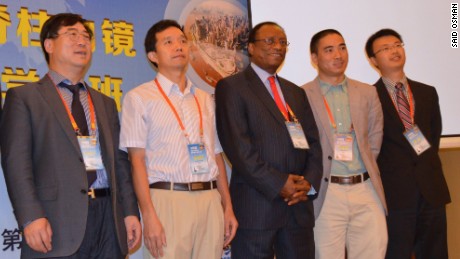By Jim Stenman, CNN
London (CNN)Said Osman found his life’s calling after witnessing a tragic scene as a young boy that still haunts him decades later.
The pioneering Kenyan doctor was just nine years old when a girl was rushed across the border from southern Ethiopia to northern Kenya. A few years his senior, she was severely dehydrated and barely holding on.
“Everyone was trying to resuscitate her and my uncle, a local pharmacy technician, saw the horrified look on my face. I was just a terrified kid, so he took me home.”
But Osman couldn’t get the girl off his mind. He persuaded his uncle to let him return to the hospital a few weeks later to see the girl.
He was amazed to find she had nearly made a full recovery — something that would inspire him to help others later in life.
“Another human being managed to bring her back to life and I should also be able to do the same if I try my best,” he recalls thinking.
Though friends and family laughed off Osman’s interest in medicine, his mother voiced her support.
“You know, these guys have never seen a black doctor before,” she said at the time.
Looking back, Osman admits their reaction wasn’t too surprising. He was, after all, living in a rural part of Kenya where nomads form most of the population.
But he refused to let that stand in the way of pursuing his dream — a journey that has taken him far away from his ancestral home and, eventually, to the United States.
Medical milestone
Osman is currently based in Frederick, Maryland, near Washington D.C., and best known as a pioneer in endoscopic spine surgery.
Patients, who are usually required to spend days in hospital, can often walk out of his clinic just hours after surgery.
A fellow doctor from Hawaii became the world’s first patient to undergo one of Osman’s endoscopic spine surgeries in the mid 1990s. A medical milestone, it was the culmination of several years of research.
He called Osman three days after his surgery declaring: “It’s the first time in four years that I’m able to stand on one leg while putting on my pants.”
But back surgery doesn’t come without serious risks. Patients undergoing a currently popular minimally invasive surgery (direct lateral approach for lumbar spinal fusion) face a complication risk of up to 67%. Moreover, such procedures often result in some form of nerve damage.
Osman is able to dramatically reduce those numbers by drilling a hole through the pelvic bone. This allows him to access the injured lowest lumbar disc while avoiding damage to spinal muscles or entry into the spinal canal, where nerves can be injured. It also doesn’t involve access through the abdomen.


